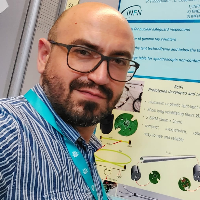Preprint
Article
Field Test of the MiniRadMeter Gamma and Neutron Detector for the EU Project CLEANDEM
Altmetrics
Downloads
52
Views
20
Comments
0
A peer-reviewed article of this preprint also exists.
Submitted:
01 September 2024
Posted:
02 September 2024
You are already at the latest version
Alerts
Abstract
In the framework of the H2020 CLEANDEM project a small robotic vehicle was equipped with a series of different sensors, developed for the preliminary inspection of areas possibly contaminated by radiation. Such unmanned inspection allows to identify dangerous locations prior to the possible start of human operations. One of the developed devices, named MiniRadMeter, is a compact, low-cost sensor to perform gamma and neutron radiation field mapping of the environment. The MiniRadMeter was successfully tested in a simulated field mission with four "hidden" radioactive sources and a neutron generator. In this work we describe the test procedure and the results, also supported by the outcome of dedicated Monte Carlo simulations.
Keywords:
Subject: Physical Sciences - Radiation and Radiography
1. Introduction
The present and future nuclear decommissioning activities, as well as possible accident remediations, will certainly require to reduce the physical presence of human operators in potentially radiologically hostile environments and the consequent risks by means of robotic equipment. The CLEANDEM project (Cyber physicaL Equipment for unmAnned Nuclear DEcommissioning Measurements), whose motto was “Safer, Cleaner, Better, Faster, Cheaper”, was funded in the framework of the EU Horizon 2020 plan [1] and was recently concluded with the construction of the foreseen UGV (Unmanned Ground Vehicle) and its test in a realistic environment. This UGV, perhaps a first of a kind demonstrator, hosts several sensors and devices (Figure 1a) and can also be equipped with a special arm to manipulate additional sensors. An onboard LIDAR (Laser Imaging Detection and Ranging) system provides the capability of a 3D mapping of the surrounding environment which can be associated with the radiological measurement results and the internet connection is used to provide the universal time stamp. One of the devices permanently installed on top of the UGV front pole is the MiniRadMeter, devoted to measurements of the gamma and neutron radiation in the environment and whose full description of the components and expected performances were given in [2]. It is well known that the main types of radioactivity are alpha, beta, gamma, neutron and fission. While alpha particles and fission fragments are immediately stopped in very thin layers of matter, with beta electrons traveling a little more but anyway stopped e.g., in a thin aluminum sheet, neutrons and gamma rays are much more penetrating and may require thick lead, concrete and/or water to be stopped. As a side effect they are also easier to detect, and therefore a quick and effective radiological survey should primarily be based on gammas and neutrons, considering also that almost any kind of radioactive decay usually implies also the emission of gamma radiation, while neutrons indicate the presence of alpha-emitting actinides or fissile species.
In this work we describe the test of the MiniRadMeter in a simulated field mission with four “hidden” radioactive sources and a neutron generator, along with the test procedure and the results, also supported by the outcome of dedicated simulations. The mission was performed on the premises of AiNT GmbH [3], member of the CLEANDEM consortium. The full description of the UGV and of all its sensors is foreseen as the subject of forthcoming papers.
2. Materials and Methods
2.1. The MiniRadMeter Sensors and the Control System
The gamma ray detector is a CsI(Tl) crystal, 1×1×1 cm3 size, optically coupled to a Silicon Photo Multiplier (SiPM) MicroFC-60035-SMT [4]. It is a radiation counter that provides good detection efficiency and medium energy resolution at very reasonable cost [2,5,6]. After a suitable calibration the detector provides the spectrum of the energy deposited by gamma rays, whose integral is the overall number of counts that can be rescaled to dose rate dividing by the measuring time and multiplying by a conversion coefficient.
As for the neutron detector the SiLiF technology was chosen: a film of 6LiF neutron converter is placed in front of a silicon detector which provide a signal when hit by either a triton or an alpha particle emitted following neutron capture in 6Li [7,8,9,10,11,12,13]. The detector, which requires a once-only calibration, provides the spectrum of the energy deposited by charged particles. A suitable threshold of 1.5 MeV completely removes any significant gamma contribution, so that every count above the threshold is to be ascribed to neutrons. The chosen configuration employs two silicon photodiodes [14], 1×1 cm2 size, installed back-to-back and each one facing a 6LiF film deposited on a glass substrate [13]. The neutron detector assembly, whose thermal neutron detection efficiency is 5%, is placed inside a polyethylene box 6×6×6 cm3 acting as a moderator.
The data acquisition system has two analog front-ends, one for each sensor, and a single ADC with two differential input channels handled by a Raspberry Pi4 microcomputer board [15] that collects, elaborates and stores the data. The microcomputer takes also care of connecting to the global storage database and optionally to the user interface software, written in Python and running on a standard PC, through the UGV wireless connection or directly via its own WiFi interface. A closer view of the MiniRadMeter and its components is shown in Figure 1b. A snapshot of the user interface control screen is shown in Figure 2.
2.2. Gamma Detector Calibration
A preliminary calibration of the gamma detector was done by means of two pointlike sources, namely 137Cs (282 kBq) and 60Co (352 kBq). Each source was placed on a holder at 17 cm from the detector (Figure 3) and a spectrum was acquired. The three energy peaks from the sources, respectively at 662, 1173 and 1330 keV, were used to perform a linear calibration. As a cross check of the calibration goodness we looked at the position of the 184 and 212 keV Compton backscattering peaks in the spectra, which resulted exactly where expected. The background spectrum was also acquired (Figure 4).
The count rate to dose rate conversion was done, as indicated in [2], by referring to the usual calibration of active dosimeters based on the 662 keV gamma radiation from 137Cs: the equivalent dose rate produced by such a source of 1 MBq activity at 1 m distance is 0.1 µSv/h. The interaction probability in CsI(Tl) is about 30% [16], the subtended solid angle gives rise to a flux of about 8 gamma/cm2/s, resulting in about 2.7 counts/s in the detector as also verified experimentally. These considerations lead to a conversion factor of about 0.037 (µSv/h)/(counts/s).
3. Results: Field Mission
A simulated field mission was arranged in order to verify the behavior of the MiniRadMeter in a realistic environment. A shielded hall was made available at AiNT, that was perfect for a gamma test mission. Unfortunately, a realistic neutron detection mission was unfeasible as it would require to place an intense neutron source that (i) was not available; (ii) would have posed operational risks for its placement and removal. However, an alternative solution was found as described in the following.
3.1. Gamma Detection Mission
For the gamma detection mission four sources were placed in three locations inside the measurement hall, as shown in Figure 5: 241Am (490 kBq), 152Eu (465 kBq), 137Cs (282 kBq) plus 60Co (352 kBq). The UGV was sent into the hall and teleguided from a distance of several meters by an operator standing beyond a chain which delimited the radiation area. Even though the path included continuous motion and pauses, we subdivided it into 53 main steps of 20 seconds duration. The MiniRadMeter kept acquiring data throughout the mission, alternating measurements of gamma and neutrons every 10 seconds.
Figure 6 shows a global summary of the gamma mission: the top plot shows the followed path with the indication of the 53 positions, whereas the bottom bubble plot indicates the corresponding measured dose rates with numbers, in µSv/h, and bubble size. The position and activity of the sources are shown as well. The counting rate data in each position were converted into dose rate and plotted in Figure 7 as a function of the position number, providing a useful profile along the UGV inspection path. The full path was roughly grouped into six locations, denoted with the a-f tags on the plot, and the corresponding measured average dose rates are reported in Table 1. In Figure 8 we show the six spectra measured during the mission in the respective locations. Despite of the low collected statistics, due to the short data collection time, one can appreciate differences in the shape and in the overall counting rates. In particular, in Figure 8c, d and e we also show the position of the main peaks expected from the employed sources (in c also the position of the Compton shoulders is indicated), which provide a hint to a possible isotope identification along with the measured counting rates indicated on the plots and listed in Table 1. Obviously, in order to (try to) identify the emitting isotopes one would require the UGV to stop in front of the positions of interest for a longer time.
3.2. Neutron Detection Mission
The overall spectrum of the energy deposited in the neutron detector during the gamma mission, shown in Figure 9, basically indicates that there was no neutron emission in the area: one neutron detected in 530 seconds is compatible with environmental background. Profiting by the availability of a neutron generator inside the shielded hall at AiNT, a dedicated neutron mission was done with the MiniRadMeter placed on a tray just facing its output window (Figure 10). The neutron flux and spectrum in such a position and geometrical arrangement was not well known, even though it was estimated between 1×104 and 4×104 n/cm2/s. This is why the mission was prudentially performed with the MiniRadMeter alone in order to prevent a possible damage to the UGV and/or other equipment onboard. An acquisition of 150 seconds was run and a rate of about 100 counts/s of thermalized neutrons was measured. Given the 5% detection efficiency, this corresponds to ≈ 2000 thermal neutrons/s/cm2 on the SiLiF detector. Assuming a ≈ 10% average thermalization efficiency [2] we roughly estimated an incoming flux of the order of 2×104 n/cm2/s, compatible with the coarse expectation from the generator in the employed operating conditions. In Figure 11a we show the deposited energy spectrum where the threshold of 1.5 MeV, recommended for an optimal gamma rejection [7,8], is highlighted. In this particular case the only gamma rays to be expected were 473 keV and 2.2 MeV, produced by neutron capture respectively on Boron and Hydrogen in the borated polyethylene incorporating the generator. The contribution of these gamma rays into the spectrum comes only from Compton scattering and above 1.5 MeV it is basically null. As a check we also looked at the spectrum recorded by the gamma detector while measuring at the neutron generator, that is shown in Figure 11b. A prominent peak at 473 keV is visible, as expected, along with the bump at 166 keV from its Compton backscattering. The long tail at higher energy is likely due to the Compton scattering of the 2.2 MeV gamma rays and by neutron activation of the surrounding materials.
4. Discussion
Since the gamma detector is not simply a counter, but also produces a spectrum, it makes possible to measure the dose rate in a more appropriate fashion, i.e., by measuring the energy effectively deposited on the crystal. Thus, the average dose rates in the a-f regions were calculated by means of the weighted integral of each spectrum, according to Eq.1.
where
D = dose rate in µSv/h;
E = energy value of the spectrum bin in eV;
c = spectrum counts in the bin E;
e = 1.6·10-19 is the electron charge in Coulomb;
t = data collection duration in seconds;
m = mass of the crystal, i.e., 0.00451 kg;
106 is required to go from Sv to µSv, and 3600 is the number of seconds in one hour.
The obtained values, along with their statistical uncertainty, are listed in Table 1 and denoted as measured. The agreement between direct and measured values looks fairly reasonable. However, as a further verification of the correctness of the order of magnitude we also ran a few simulations using the FLUKA [17] and Flair [18] software. A skeletal geometric reconstruction of the UGV in front of the sources was reproduced and the approximate distances between the sources and the gamma detector were estimated by means of several videos and photographs taken during the mission. Three configurations were simulated, and the resulting expected dose rate profile was produced for the three main positions in front of the 137Cs + 60Co (Figure 12), 241Am (Figure 13) and 152Eu (Figure 14) sources, along with the corresponding pictures. Even though the exact geometry was not implemented, the resulting simulated dose rate values, listed in Table 1, are fairly close to the values obtained with the MiniRadMeter.
A simulation was also performed for the neutron measurement with the generator. The neutron spectrum in the measurement position was not known, as it was outside the generator itself. We presumed the real spectrum should have a well thermalized component, because of the massive polyethylene moderator, and a partially moderated higher energy one exiting the access window almost directly. The proportions were not known, therefore we simulated separately three beams of 2×104 n/cm2/s, over a 6×6 cm2 area, for the three impinging neutron energies 25 meV, 100 keV and 1 MeV. The resulting flux distributions are shown in Figure 15.
By looking at the Figure 15b one can see how the thermal neutron flux is mainly localized in the moderator, where neutrons are kept bouncing for a while and then scattered away or captured in hydrogen, while a small fraction interacts with the 6LiF converter and the produced 3H and/or 4He are detected by the silicon diode. When the neutron beam energy is increased to 100 keV (Figure 15c) and to 1 MeV (Figure 15d) the flux increases more deeply in the moderator and in the electronics box. The three corresponding spectra of the energy deposited in the silicon detector, reported in Figure 16, show that the assumptions about the real flux are reasonable by comparison with Figure 11a. The total and the neutron counts (i.e., for E > 1.5 MeV) in the spectra of Figure 16 and Figure 11 are listed in Table 2.
Two important features of the MiniRadMeter to be investigated are the Minimum Detectable Activity (MDA) and the Minimum Detectable Neutron Flux (MDNF) for the gamma and for the neutron detectors respectively. To calculate the MDA in the described operating conditions we refer to the 662 keV gamma rays from a pointlike 137Cs source, knowing that the gamma interaction probability in 1 cm of CsI(Tl) is about 0.3 [16] and the geometrical efficiency is a function of the distance between the source and the detector. Considering a data collection duration of 10 seconds, and an average background rate of about 4.04 counts/s measured in 80 seconds as reported in Figure 8f and Table 1, the MDA95%, i.e., at 95% confidence level, can be calculated (in Becquerel) by means of Eq.2 [19,20,21]
where
Rb = background count rate;
ts = sample count time;
tb = background count time;
E = detector efficiency in counts/decay, i.e., 0.3 times the geometric efficiency.
The results as a function of the source-detector distance are plotted in Figure 17, considering that the position where the MiniRadMeter is installed on the UGV is such that the minimum distance from a possible radiation source is about 30 cm. Just for comparison, the same calculation was done and the results plotted for another case, where we assumed a sampling time of 60 s and a background collection time of 300 s. The plot can be taken as a reference as it shows that even a scan of 10 s makes possible to successfully detect a gamma source with activity of the order of a few 105 Bq within one meter distance. The upper limit of the system is the high-rate capability. Indeed the 20 µs signal integration time we employed can be lowered to 5 µs with little influence on the energy resolution, thus implying a counting rate limit of the order of 100000 counts/s. By means of the previous calculation we translated this limit into an activity upper limit as a function of the distance which is plotted in Figure 17 as well.
A slightly modified version of Eq.2, where the efficiency E is replaced by the average intrinsic detection efficiency, can be exploited to calculate the MDNF. The measurement during the gamma mission produced only one neutron count in 530 s. For our estimate we assume this as a background rate and consider a sampling duration of 10 s. In the case of a thermal neutron flux, therefore running without moderator, the detection efficiency is 5% and gives rise to MDNF ≈ 6.9 neutrons/cm2/s. If running with the moderator, thus assuming a worse average detection efficiency ε ≈ 0.5% for neutrons between thermal and 1 MeV energy, the resulting value is MDNF ≈ 69 neutrons/cm2/s.
In the end, after validating the reliability of the numerical simulations and calculating the detection limits of the MiniRadMeter, we set up a simplified geometry in order to see what the detector performance could be in a realistic condition. In Figure 18 we show a presumable environment to be inspected, that is a long tunnel with pipes, valves, cables. We assumed that a 70 cm section a vertical pipe, whose midpoint is located at 2.5 m height, is contaminated with 10 MBq of 60Co. While the UGV moves along the corridor it reaches a position where the distance between the pipe’s midpoint and the gamma detector is about 2 m. The calculated MDA for such a distance in ten seconds is ≈ 4 MBq for 137Cs, that roughly scales down to 2 MBq for 60Co due to the two gamma rays emitted per decay, meaning that the activated pipe would be easily detected. The simulated counting rate is 20 counts/s, the deposited energy spectrum (ideal) and the corresponding one convoluted with the typical detector resolution of 7% FWHM at 662 keV are shown in Figure 19.
5. Conclusions
The MiniRadMeter device, developed in the framework of the H2020 CLEANDEM project, was installed on an unmanned ground vehicle. A simulated field mission was performed in a shielded hall with four “hidden” radioactive sources and a neutron generator, to prove its capability as a quick scanner for gamma and neutron radiation mapping in case of decommissioning and/or nuclear accident remediation. The data collected during the mission were validated by numerical simulations. Despite its low cost and compact size the MiniRadMeter showed interesting performance in terms of reliability and sensitivity. The quantified minimum detectable gamma activity and neutron flux make it suitable for the task it was aimed at. The overall features of this device make it an interesting candidate for the installation onboard small flying drones to be operated indoor or outdoor, in environments where it can fly in hummingbird fashion for close inspection of possibly contaminated rooms and locations.
Author Contributions
Conceptualization, P.F.; methodology, P.F., L.C., P.M. and M.R.; software, F.R. and P.F.; simulation, G.E.P., F.L., P.F.; validation, P.M., M.O., M.R., F.R., L.C., G.E.P., F.L. and P.F.; formal analysis, P.F. and M.R.; electronics, F.R. and P.M.; detector design, P.F., L.C., G.E.P. and F.L.; data curation, F.R., P.F. and M.R.; writing—original draft preparation, P.F.; writing—review and editing, P.F., P.M., F.R., M.O., L.C., G.E.P., F.L. and M.R.; supervision, P.F.; project administration, P.F. and M.R.; funding acquisition, P.F. and M.R. All authors have read and agreed to the published version of the manuscript.
Funding
This research was funded by EU Horizon 2020, project name CLEANDEM, Grant Agreement n. 945335.
Data Availability Statement
The data presented in this study are available on request from the corresponding author.
Acknowledgments
We thank all the partners of the CLEANDEM consortium for the support provided throughout the project and during this test. In particular we want to thank Bo Fu (AiNT), Maugan Michel (CEA), Camille Theroine (ORANO), Ivan Villaverde de la Nava (Tecnalia), Fernando Menchetti (RINA), Federica Pancotti and Rossella Sciacqua (SOGIN).
Conflicts of Interest
The authors declare no conflict of interest. The funders had no role at all in any phase of this research.
References
- CLEANDEM EU project Horizon 2020, GA 945335. Available online: https://cordis.europa.eu/project/id/945335/ (accessed on 10 June 2024).
- Rossi, F.; Cosentino, L.; Longhitano, F.; Minutoli, S.; Musico, P.; Osipenko, M.; Poma, G.E.; Ripani, M.; Finocchiaro, P. The Gamma and Neutron Sensor System for Rapid Dose Rate Mapping in the CLEANDEM Project. Sensors 2023, 23, 4210. [CrossRef]
- Advanced Institute for Nuclear Training. Available online: https://www.nuclear-training.de/ (accessed on 2 July 2024).
- MicroFC-60035-SMT. Available online: https://www.onsemi.com/pdf/datasheet/microc-series-d.pdf (accessed on 14 June 2024).
- Longhitano, F.; Poma, G.E.; Cosentino, L.; Finocchiaro, P. A Scintillator Array Table with Spectroscopic Features. Sensors 2022, 22,4754. [CrossRef]
- Poma, G.E.; Failla, C.R.; Amaducci, S.; Cosentino, L.; Longhitano, F.; Vecchio, G.; Finocchiaro, P. PI3SO: A Spectroscopic -Ray Scanner Table for Sort and Segregate Radwaste Analysis. Inventions 2024,9,85. [CrossRef]
- Pappalardo, A.; Barbagallo, M.; Cosentino, L.; Marchetta, C.; Musumarra, A.; Scirè,C.; Scirè, S.; Vecchio, G.; Finocchiaro, P. Characterization of the silicon+6LiF thermal neutron detection technique. Nucl. Instr. and Meth. in Phys Res. A 2016, 810, 6. [CrossRef]
- Finocchiaro, P.; Cosentino, L.; Lo Meo, S.; Nolte, R.; Radeck, D. Absolute efficiency calibration of 6LiF-based solid state thermal neutron detectors. Nucl. Instr. and Meth. in Phys Res. A 2018, 885, 86. [CrossRef]
- Cosentino, L.; Ducasse, Q.; Giuffrida, M.; Lo Meo, S.; Longhitano, F.; Marchetta, C.; Massara, A.; Pappalardo, A.; Passaro, G.; Russo, S.; et al. SiLiF Neutron Counters to Monitor Nuclear Materials in the MICADO Project. Sensors 2021, 21, 2630. [CrossRef]
- Pappalardo, A.; Vasi, C.; Finocchiaro, P. Direct comparison between solid state Silicon+6LiF and 3He gas tube neutron detectors. Results in Physics 2016, 6, 12. [CrossRef]
- McGregor, D.S.; Hammig, M.D.; Yang Y.H.; Gersch H.K.; Klann R.T. Design consideration for thin film coated semiconductor thermal neutron detectors –I: basics regarding alpha particle emitting neutron reactive films. Nucl. Instr. and Meth. in Phys. Res. A 2003, 500, 272. [CrossRef]
- Phlips, B.F.; Kub, F.J.; Novikova, E.I.; Wulf, E.A.; Fitzgerald, C. Neutron detection using large area silicon detectors. Nucl. Instr. And Meth. in Phys. Res. A 2007, 579, 173. [CrossRef]
- Massara, A.; Amaducci, S.; Cosentino, L.; Longhitano, F.; Marchetta, C.; Poma, G.E.; Ursino, M.; Finocchiaro, P. 6LiF Converters for Neutron Detection: Production Procedures and Detector Tests. Instruments 2023, 7, 1. [CrossRef]
- Hamamatsu. Available online: https://www.hamamatsu.com/content/dam/hamamatsu-photonics/sites/documents/99_SALES_LIBRARY/ssd/s3590-08_etc_kpin1052e.pdf (accessed on 15 June 2024).
- Raspberry Pi4. Available online: https://www.raspberrypi.com/products/raspberry-pi-4-model-b/ (accessed on 16 June 2024).
- NIST. Available online: https://physics.nist.gov/PhysRefData/XrayMassCoef/ComTab/cesium.html (accessed on 15 June 2024).
- Fasso, A.; Ferrari, A.; Ranft, J.; Sala, P.R. FLUKA: A Multi-Particle Transport Code; CERN Technical Report No. INFN/TC_05/11; CERN-2005-10; 2005.
- Flair, Advanced graphical user interface for particle simulation programs. Available online: http://cern.ch/flair (accessed on 31 July 2024).
- DOD, DOE, EPA, and NRC. 2000. Multi-Agency Radiation Survey and Site Investigation Manual (MARSSIM), Revision 1, NUREG-1575, DOE/EH-0624, EPA 402-R-97-016, Washington, D.C., August 2000, page 6.34.
- U.S. Nuclear Regulatory Commission (NRC). Derivation of the Currie equations. Available online: https://www.nrc.gov/docs/ML1717/ML17178A298.pdf (accessed on 19 June 2024).
- Brodsky, A. 1992. Exact Calculation of Probabilities of False Positives and False Negatives for Low Background Counting. Health Physics, 1992, 63(2), 198-204. [CrossRef]
Figure 1.
(a) The CLEANDEM UGV. (b) The MiniRadMeter device hosting: the neutron moderator and detector (1); the gamma detector (2); the front-end electronics and data acquisition microcomputer (3).
Figure 1.
(a) The CLEANDEM UGV. (b) The MiniRadMeter device hosting: the neutron moderator and detector (1); the gamma detector (2); the front-end electronics and data acquisition microcomputer (3).

Figure 2.
A snapshot of the user interface control screen.
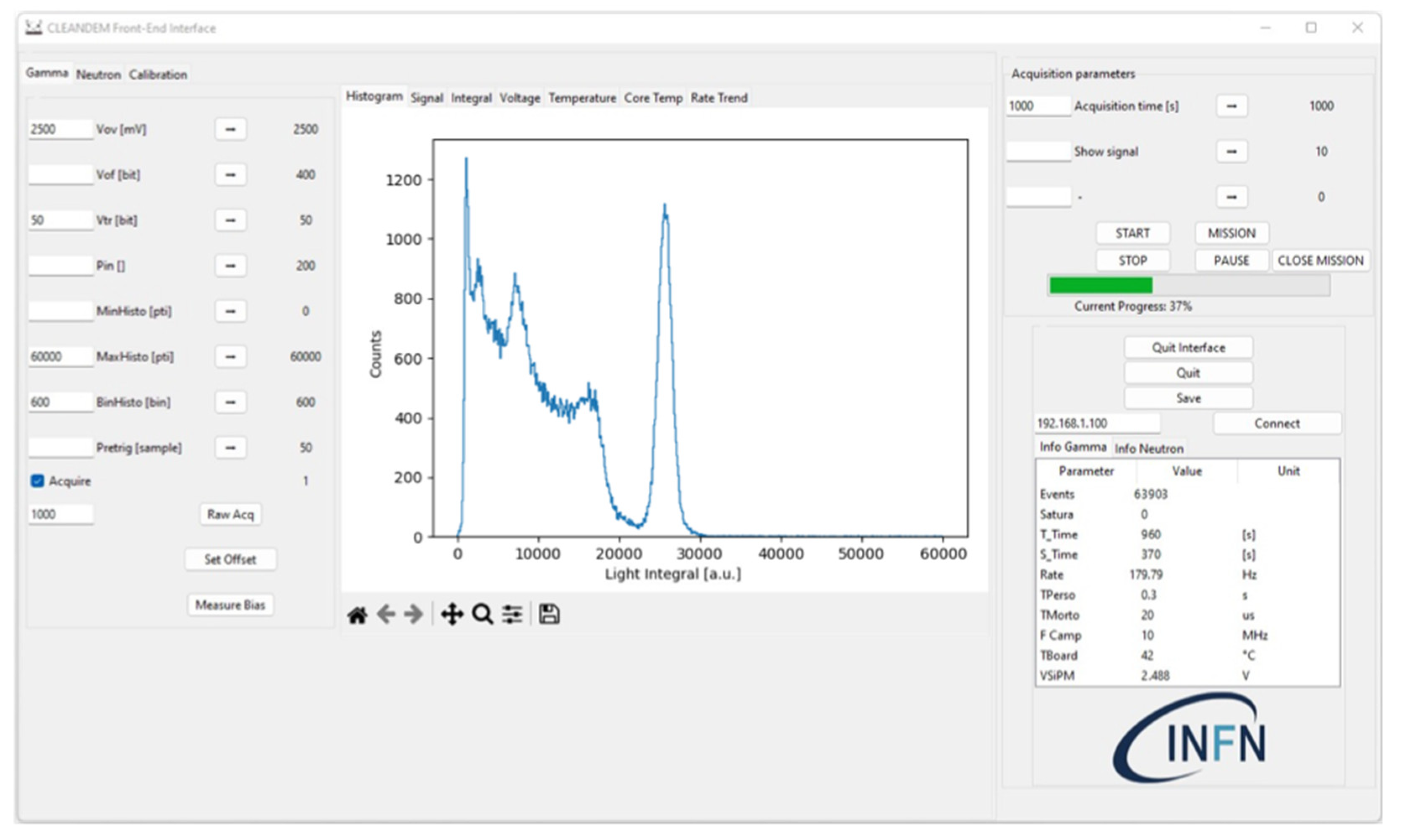
Figure 3.
The gamma detector calibration setup with the source holder at 17 cm distance.
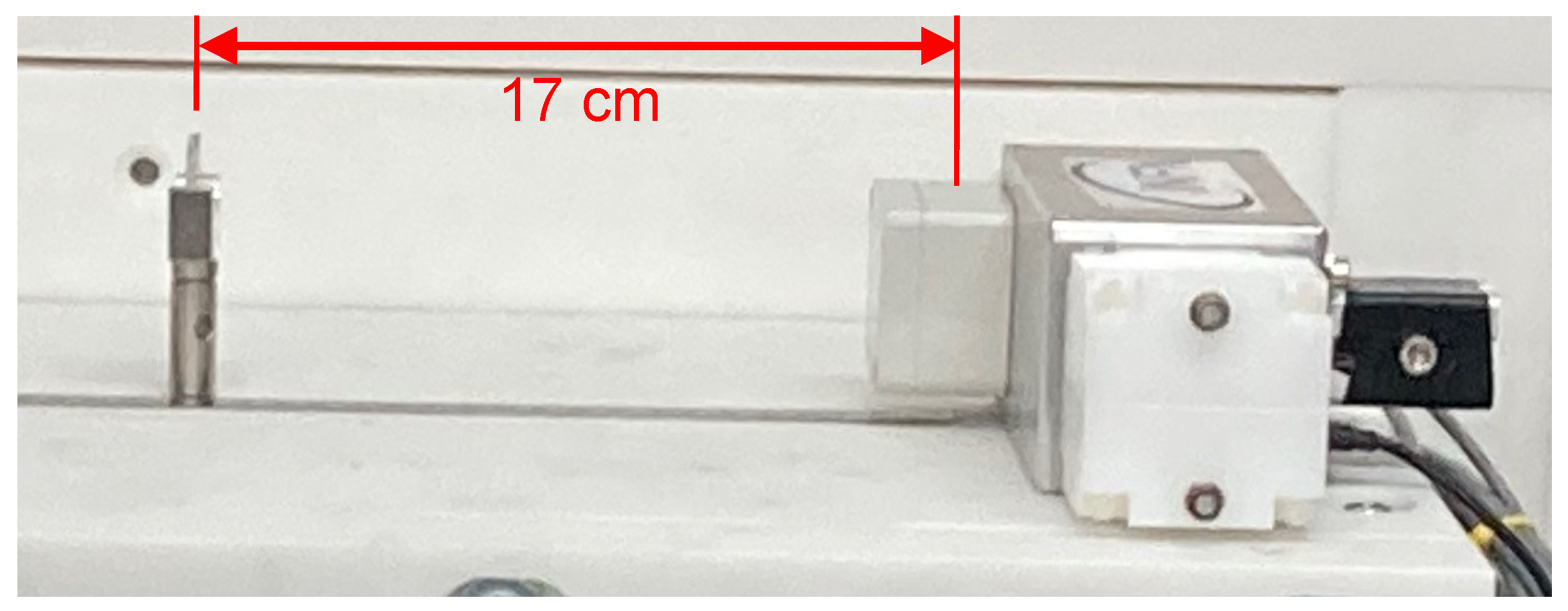
Figure 4.
(a) Spectra of the 137Cs, 60Co and background in linear y scale. The Compton backscattering peaks, located exactly where expected, testify the goodness of the linear calibration (b) Same plot in logarithmic y scale.
Figure 4.
(a) Spectra of the 137Cs, 60Co and background in linear y scale. The Compton backscattering peaks, located exactly where expected, testify the goodness of the linear calibration (b) Same plot in logarithmic y scale.
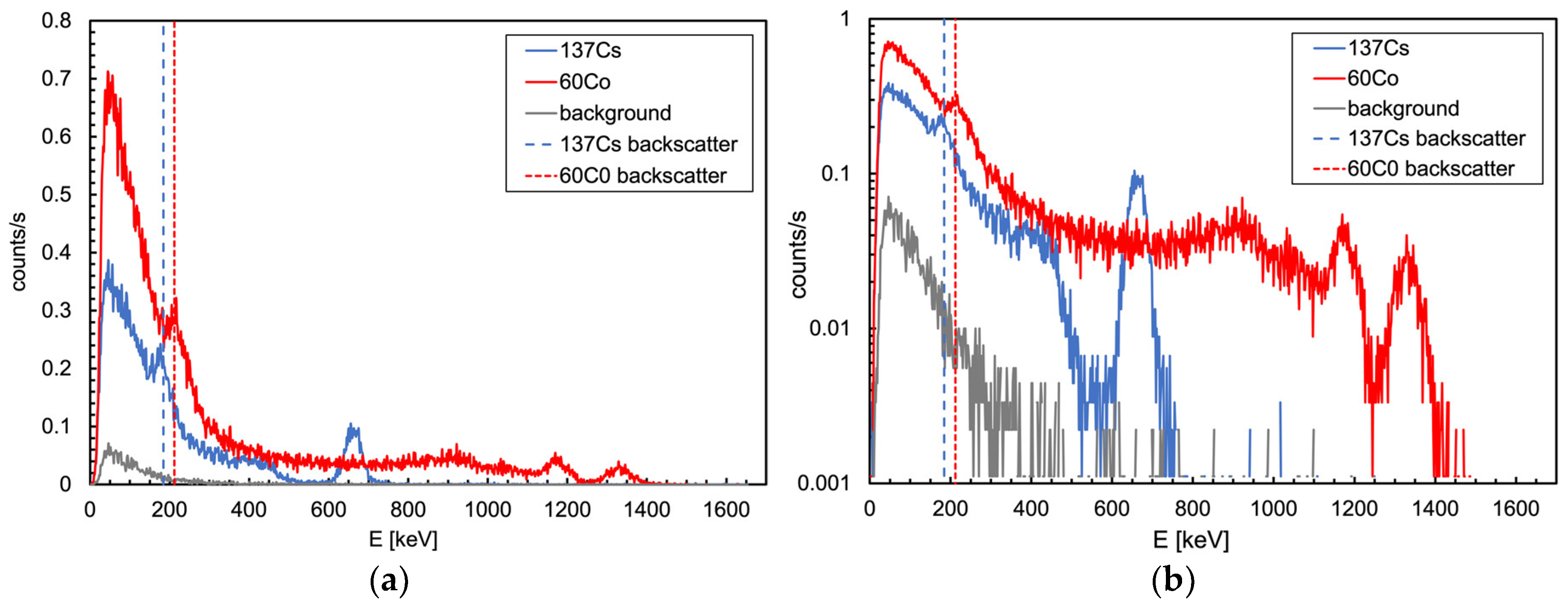
Figure 5.
The measurement hall for the gamma mission with the sources: 241Am (490 kBq), 152Eu (465 kBq), 137Cs (282 kBq), 60Co (352 kBq).
Figure 5.
The measurement hall for the gamma mission with the sources: 241Am (490 kBq), 152Eu (465 kBq), 137Cs (282 kBq), 60Co (352 kBq).
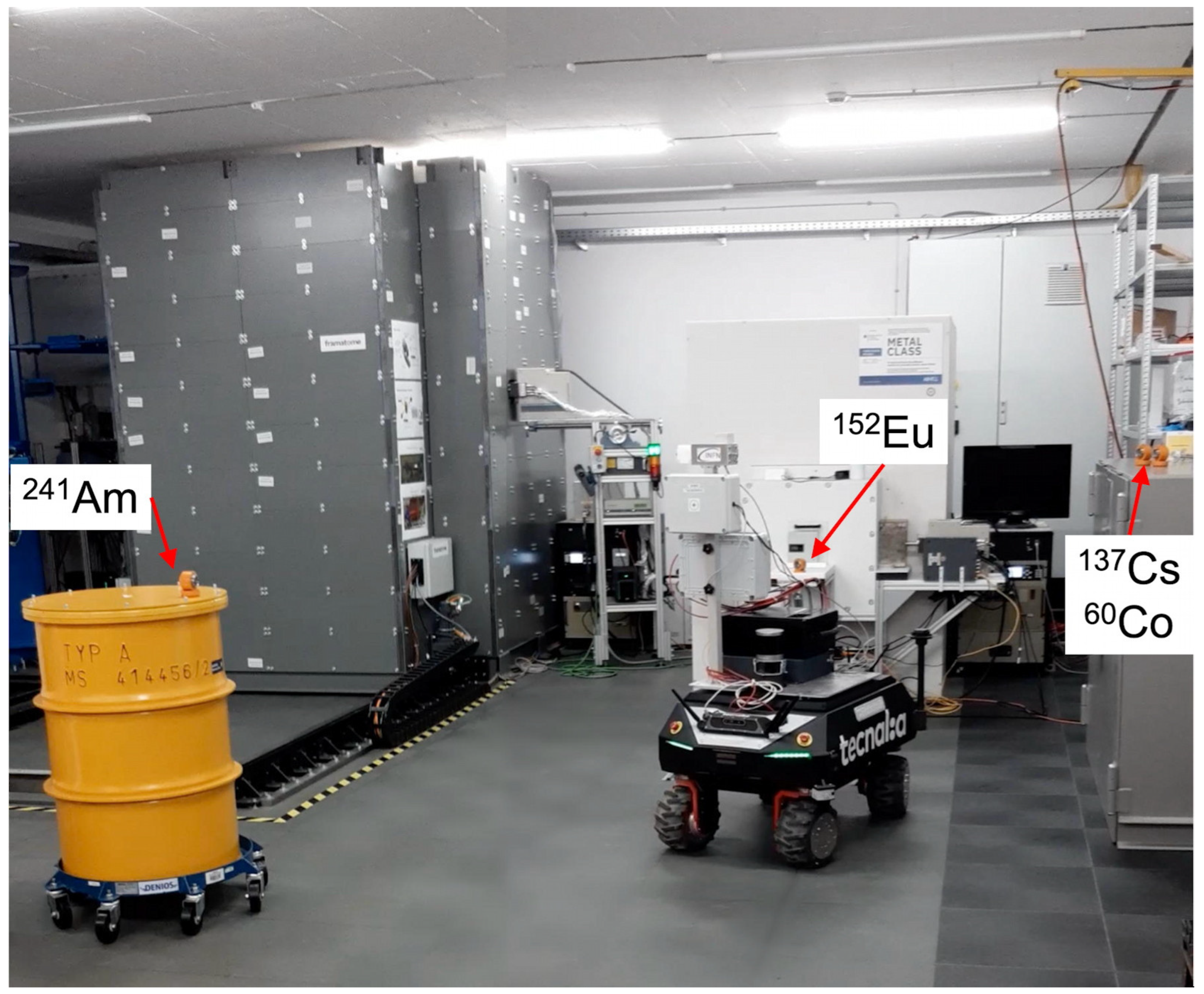
Figure 6.
Global summary of the gamma mission. (Top) The path followed by the UGV with the indication of the 53 positions. (Bottom) Bubble plot with the corresponding measured dose rates with numbers (in µSv/h) and bubble size. The indicated tags a-f correspond to the regions as listed in Table 1. The position and activity of the sources are shown as well.
Figure 6.
Global summary of the gamma mission. (Top) The path followed by the UGV with the indication of the 53 positions. (Bottom) Bubble plot with the corresponding measured dose rates with numbers (in µSv/h) and bubble size. The indicated tags a-f correspond to the regions as listed in Table 1. The position and activity of the sources are shown as well.
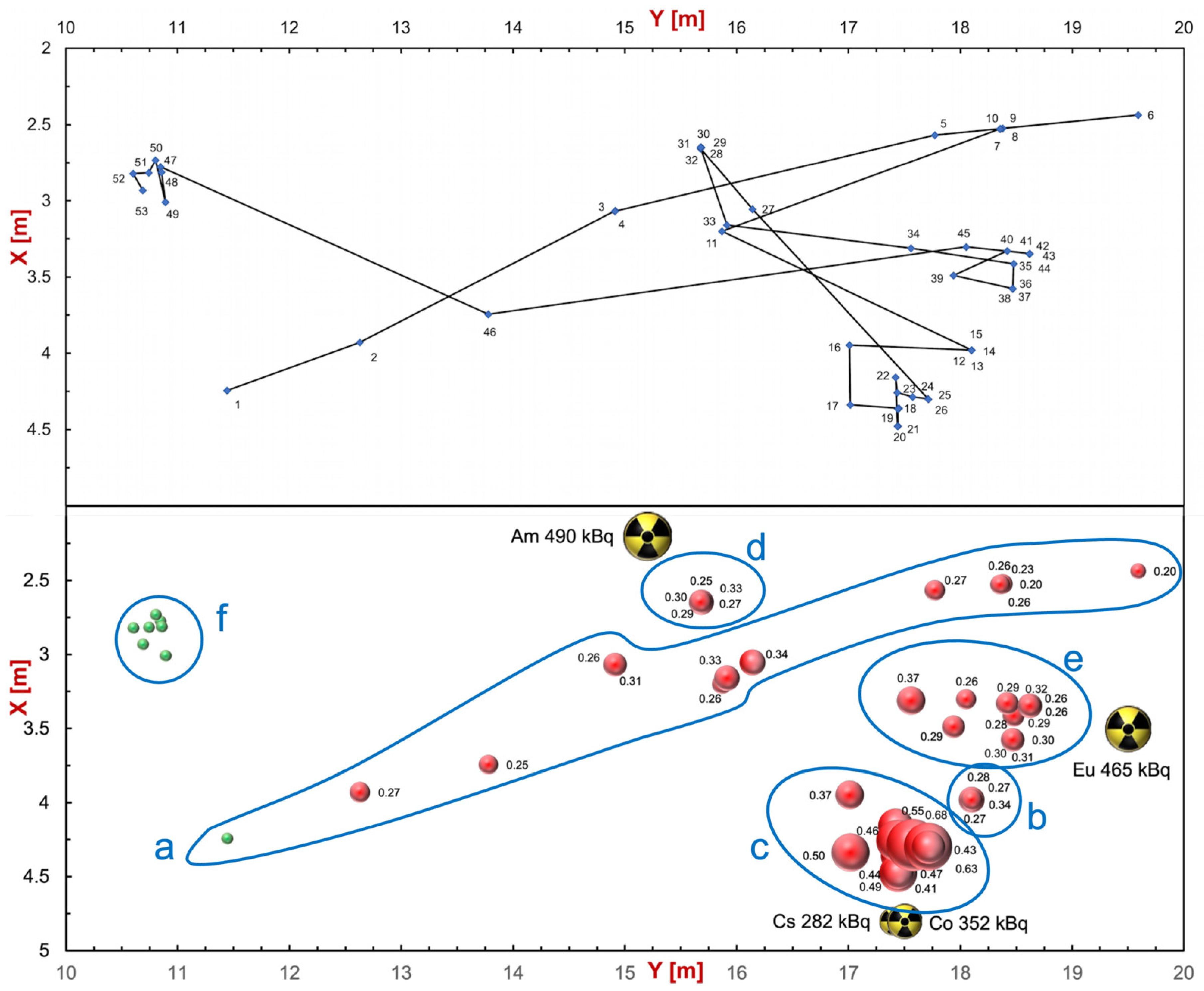
Figure 7.
Measured dose rate as a function of the position number. The full path was roughly grouped into six regions denoted with a-f as listed in Table 1.
Figure 7.
Measured dose rate as a function of the position number. The full path was roughly grouped into six regions denoted with a-f as listed in Table 1.
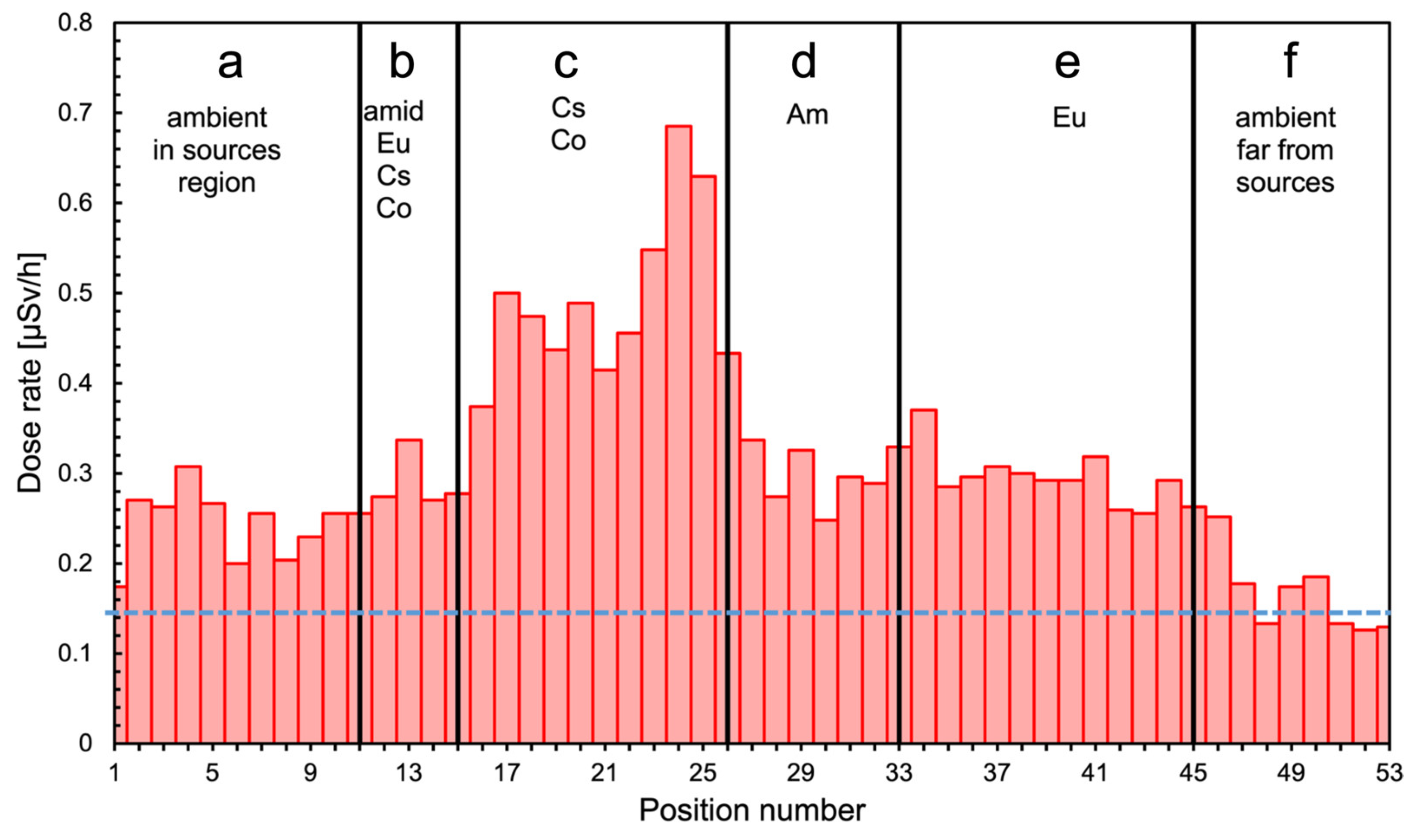
Figure 8.
Gamma spectra collected during the mission. (a) Ambient, not far from the sources. (b) In the region between the 137Cs, 60Co and 152Eu sources. (c) In front of the 137Cs and 60Co sources, the position of the three gamma peak energies and their corresponding Compton shoulders are indicated. (d) In front of the 241Am source, the position of the gamma peak energy is indicated. (e) In front of the 152Eu source, the positions of the main gamma peak energies are indicated. (f) Ambient, far from the sources.
Figure 8.
Gamma spectra collected during the mission. (a) Ambient, not far from the sources. (b) In the region between the 137Cs, 60Co and 152Eu sources. (c) In front of the 137Cs and 60Co sources, the position of the three gamma peak energies and their corresponding Compton shoulders are indicated. (d) In front of the 241Am source, the position of the gamma peak energy is indicated. (e) In front of the 152Eu source, the positions of the main gamma peak energies are indicated. (f) Ambient, far from the sources.
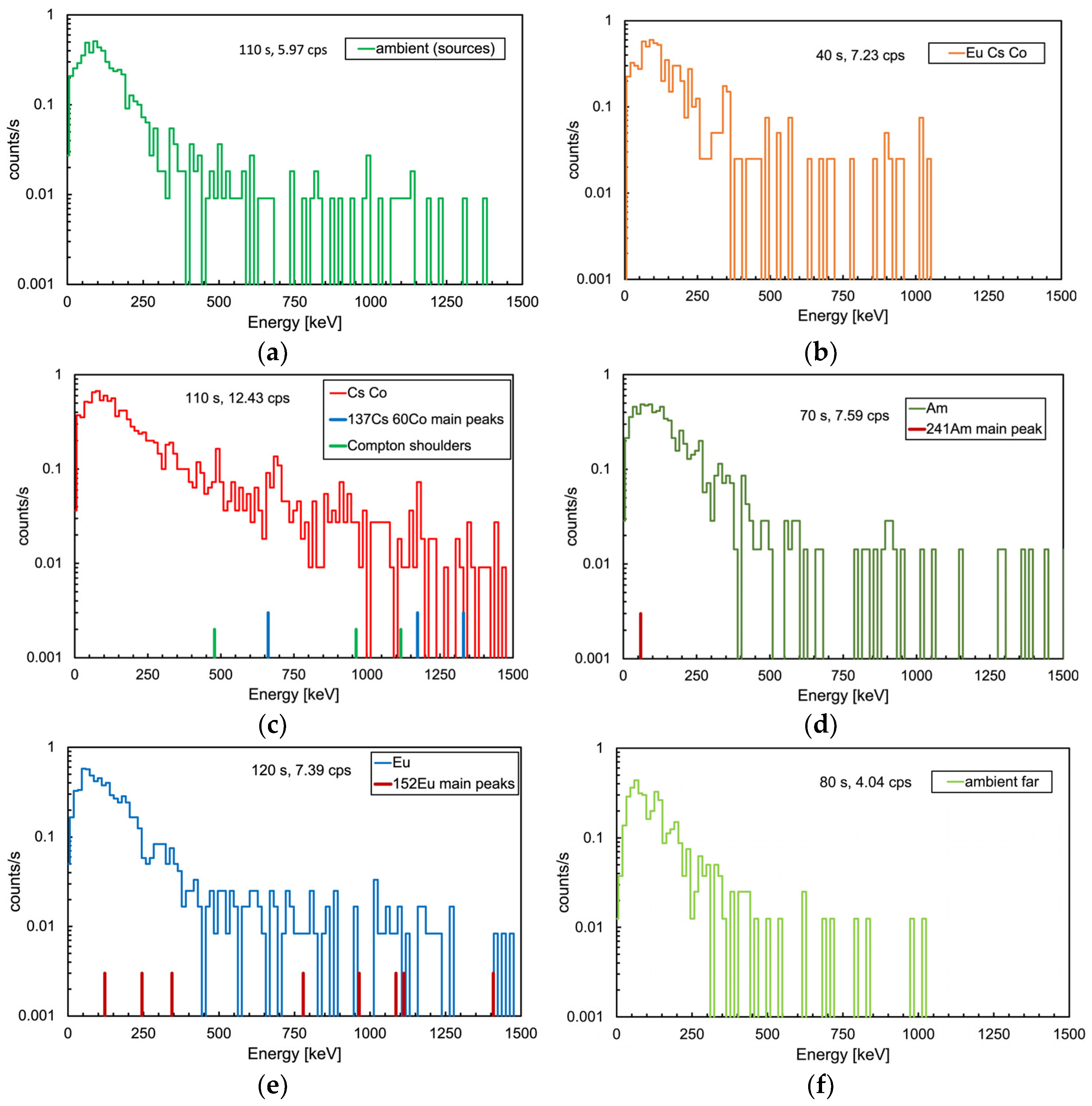
Figure 9.
Overall spectrum of the energy deposited in the neutron detector throughout the 530 seconds of the mission.
Figure 9.
Overall spectrum of the energy deposited in the neutron detector throughout the 530 seconds of the mission.
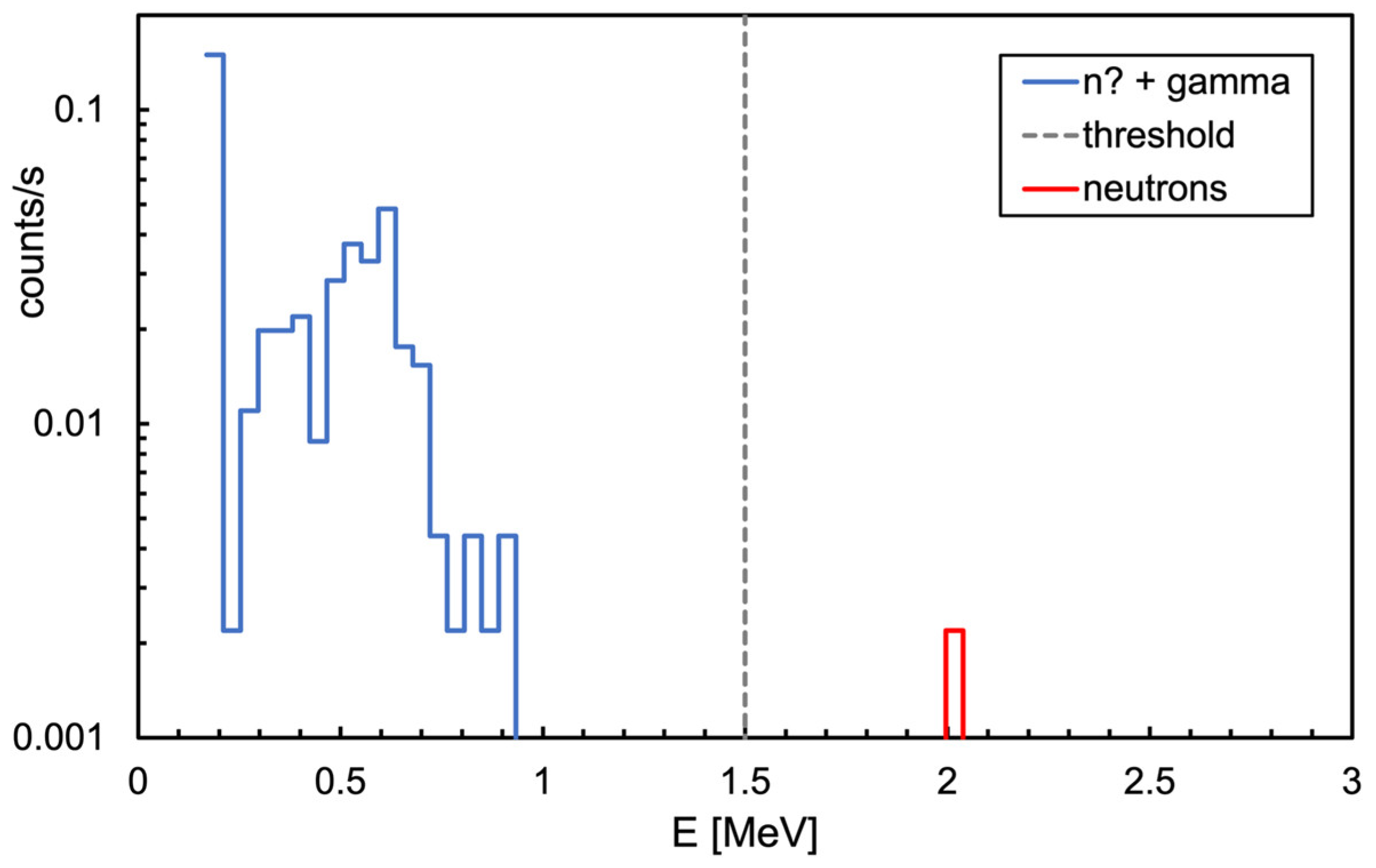
Figure 10.
The MiniRadMeter placed on a tray in front of the neutron generator output window.
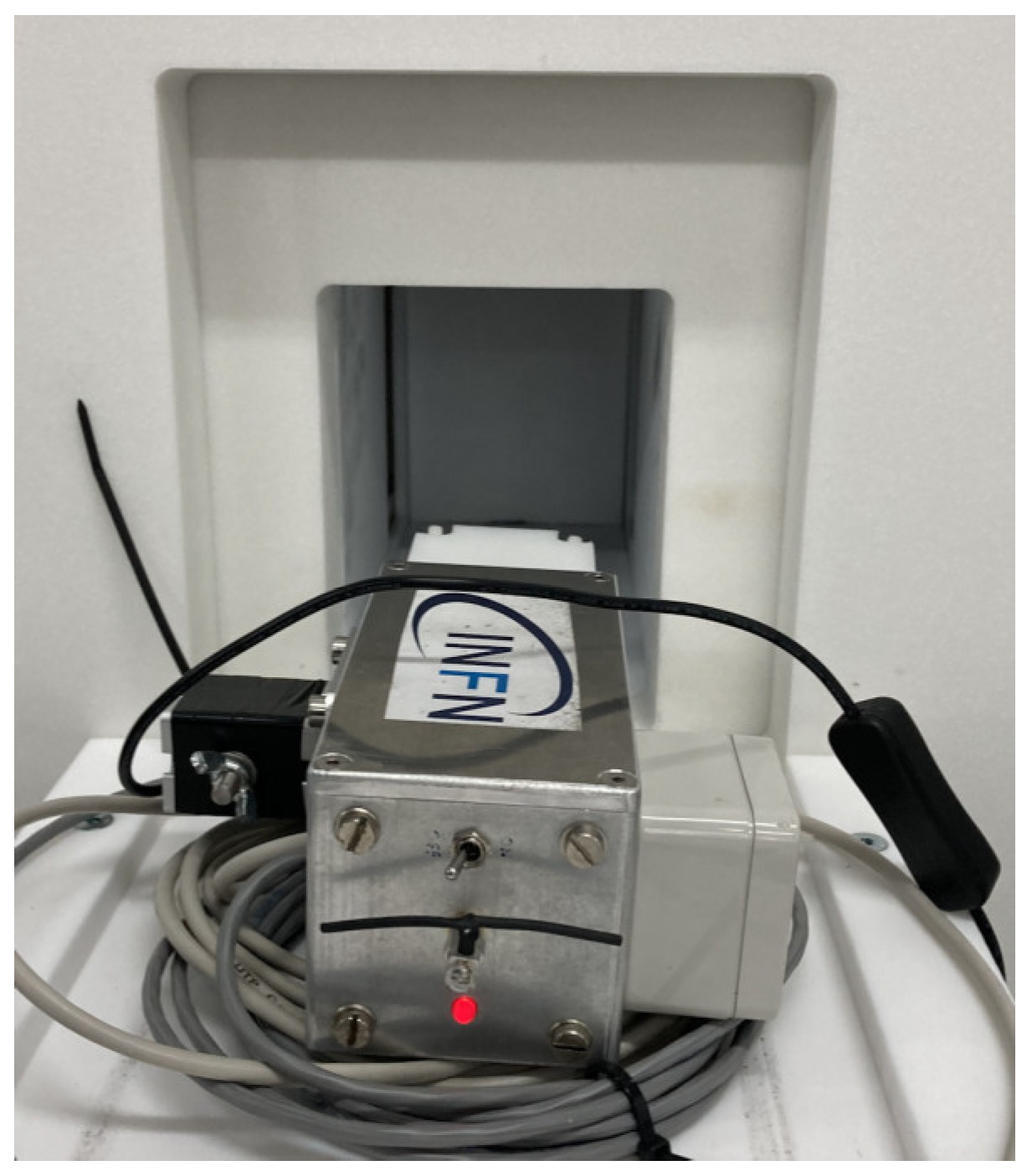
Figure 11.
(a) Spectrum of the energy deposited in the SiLiF detector. The threshold at 1.5 MeV, recommended for an optimal gamma rejection [7,8], is highlighted. (b) Spectrum recorded by the gamma detector while measuring at the neutron generator. The expected peak at 473 keV is visible, as well as the bump at 166 keV from its Compton backscattering.
Figure 11.
(a) Spectrum of the energy deposited in the SiLiF detector. The threshold at 1.5 MeV, recommended for an optimal gamma rejection [7,8], is highlighted. (b) Spectrum recorded by the gamma detector while measuring at the neutron generator. The expected peak at 473 keV is visible, as well as the bump at 166 keV from its Compton backscattering.

Figure 12.
(a) The UGV in front of the 137Cs + 60Co sources. (b top). Simulated 3D dose rate profile. (b bottom). Dose rate distribution in a vertical plane containing the gamma detector.
Figure 12.
(a) The UGV in front of the 137Cs + 60Co sources. (b top). Simulated 3D dose rate profile. (b bottom). Dose rate distribution in a vertical plane containing the gamma detector.
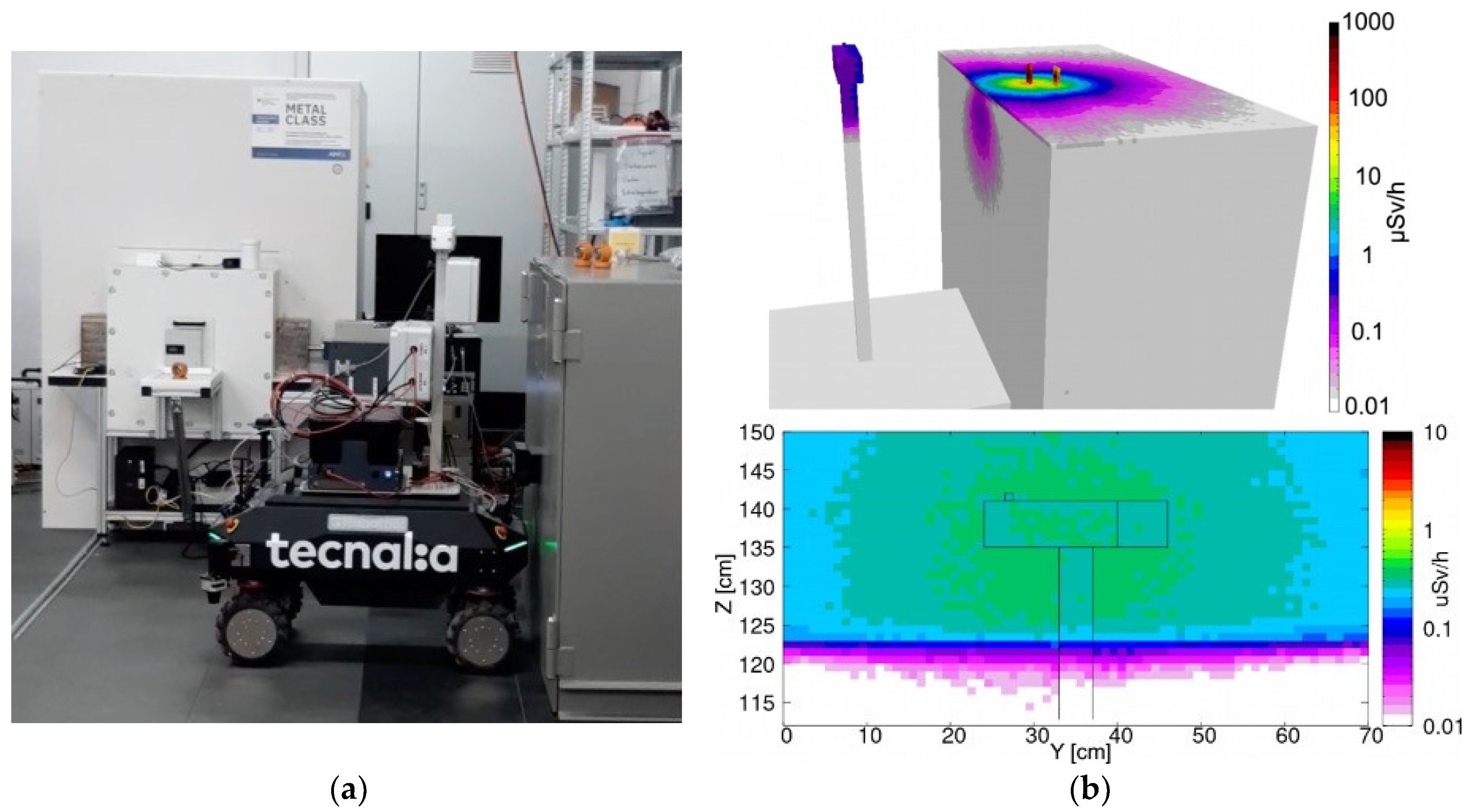
Figure 13.
(a) The UGV in front of the 152Eu source. (b top). Simulated 3D dose rate profile. (b bottom). Dose rate distribution in a vertical plane containing the gamma detector.
Figure 13.
(a) The UGV in front of the 152Eu source. (b top). Simulated 3D dose rate profile. (b bottom). Dose rate distribution in a vertical plane containing the gamma detector.

Figure 14.
(a) The UGV in front of the 241Am source. (b top). Simulated 3D dose rate profile. (b bottom). Dose rate distribution in a vertical plane containing the gamma detector.
Figure 14.
(a) The UGV in front of the 241Am source. (b top). Simulated 3D dose rate profile. (b bottom). Dose rate distribution in a vertical plane containing the gamma detector.
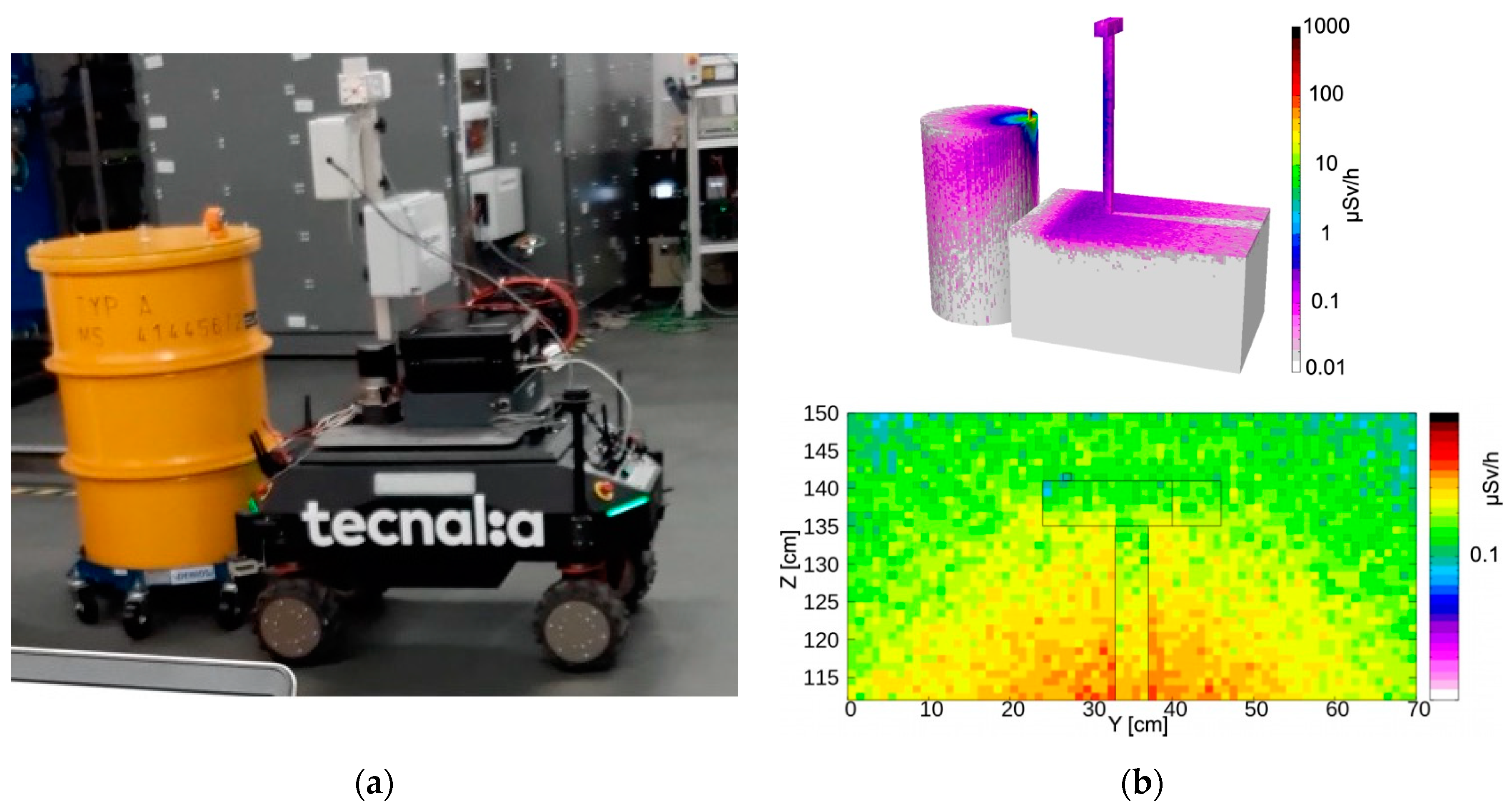
Figure 15.
Neutron flux distribution in the MiniRadMeter, simulated with an initial monoenergetic beam of 2×104 neutrons/cm2/s impinging on the moderator. (a) The simulated geometry. (b) Beam energy 25 meV. (c) Beam energy 100 keV. (d) Beam energy 1 MeV.
Figure 15.
Neutron flux distribution in the MiniRadMeter, simulated with an initial monoenergetic beam of 2×104 neutrons/cm2/s impinging on the moderator. (a) The simulated geometry. (b) Beam energy 25 meV. (c) Beam energy 100 keV. (d) Beam energy 1 MeV.
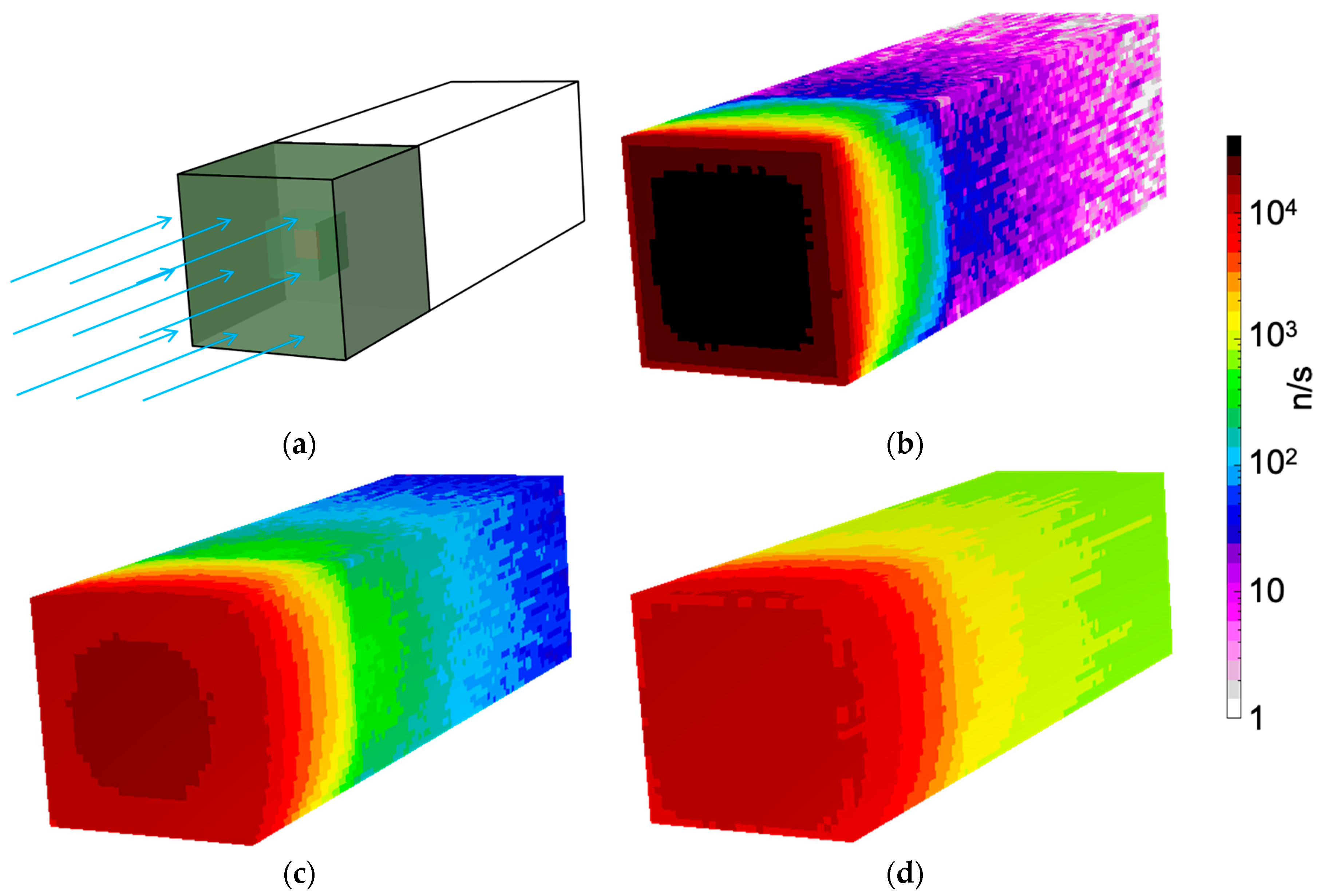
Figure 16.
(a) The deposited energy spectra in the silicon detector for the three simulated neutron fluxes of Table 2 and Figure 15b,c,d.
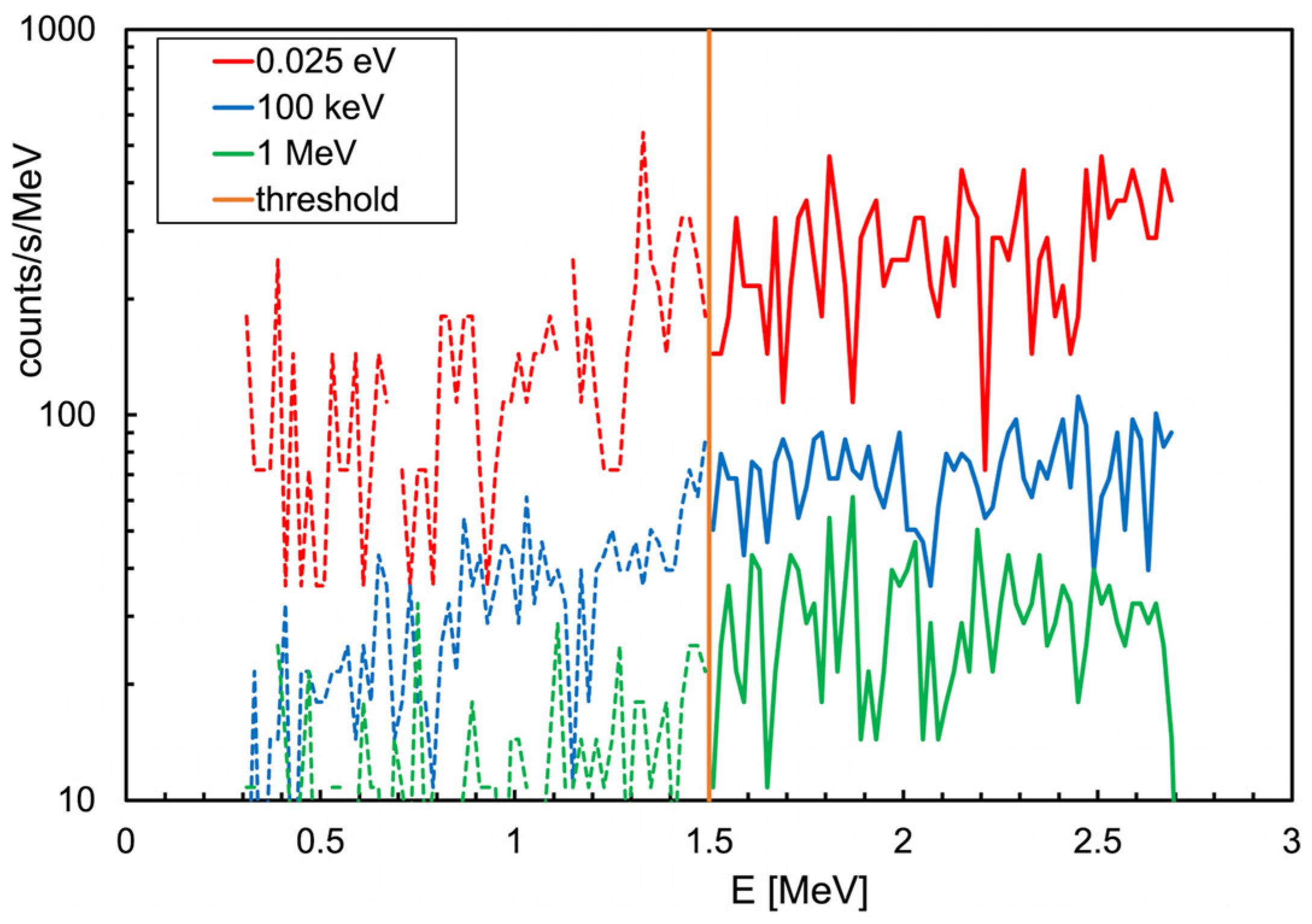
Figure 17.
Operational range of the MiniRadMeter gamma detector, between Minimum Detectable Activity and activity upper limit, as a function of its distance from a pointlike 137Cs source. Shown are two MDA cases with 10s and 60s sampling time.
Figure 17.
Operational range of the MiniRadMeter gamma detector, between Minimum Detectable Activity and activity upper limit, as a function of its distance from a pointlike 137Cs source. Shown are two MDA cases with 10s and 60s sampling time.

Figure 18.
Simulation of a hypothetical environment to be inspected: a long tunnel with pipes, valves, cables. A 70 cm vertical pipe section, highlighted in red for clarity (top left), was assumed as contaminated with 10 MBq of 60Co. The dose rate scale only refers to the UGV.
Figure 18.
Simulation of a hypothetical environment to be inspected: a long tunnel with pipes, valves, cables. A 70 cm vertical pipe section, highlighted in red for clarity (top left), was assumed as contaminated with 10 MBq of 60Co. The dose rate scale only refers to the UGV.
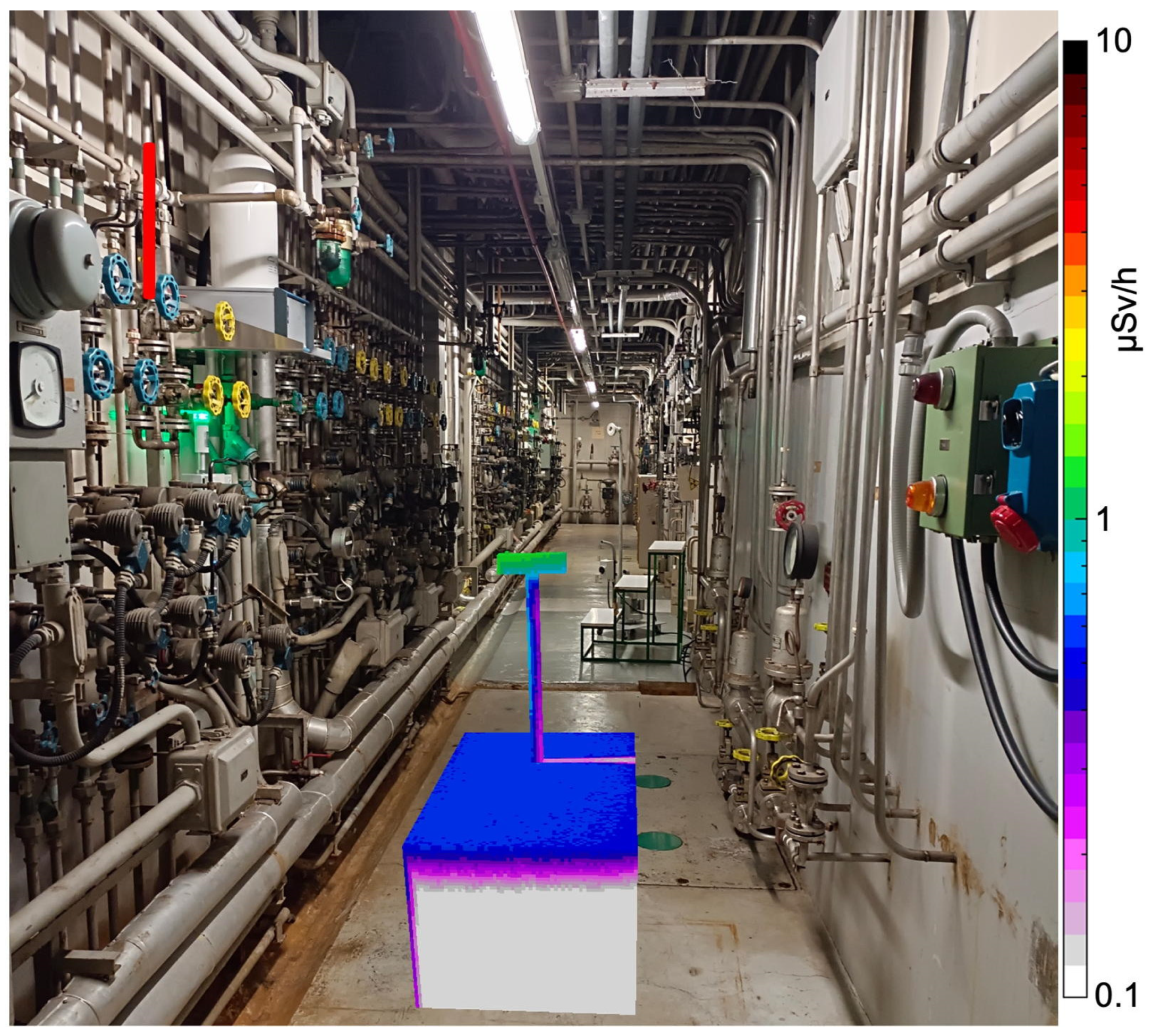
Figure 19.
Simulated spectrum of the energy deposited into the gamma detector in the configuration of Figure 18 in 10 s acquisition. (a) Ideal case with perfect energy resolution. (b) Realistic case convoluted with the typical detector resolution.
Figure 19.
Simulated spectrum of the energy deposited into the gamma detector in the configuration of Figure 18 in 10 s acquisition. (a) Ideal case with perfect energy resolution. (b) Realistic case convoluted with the typical detector resolution.
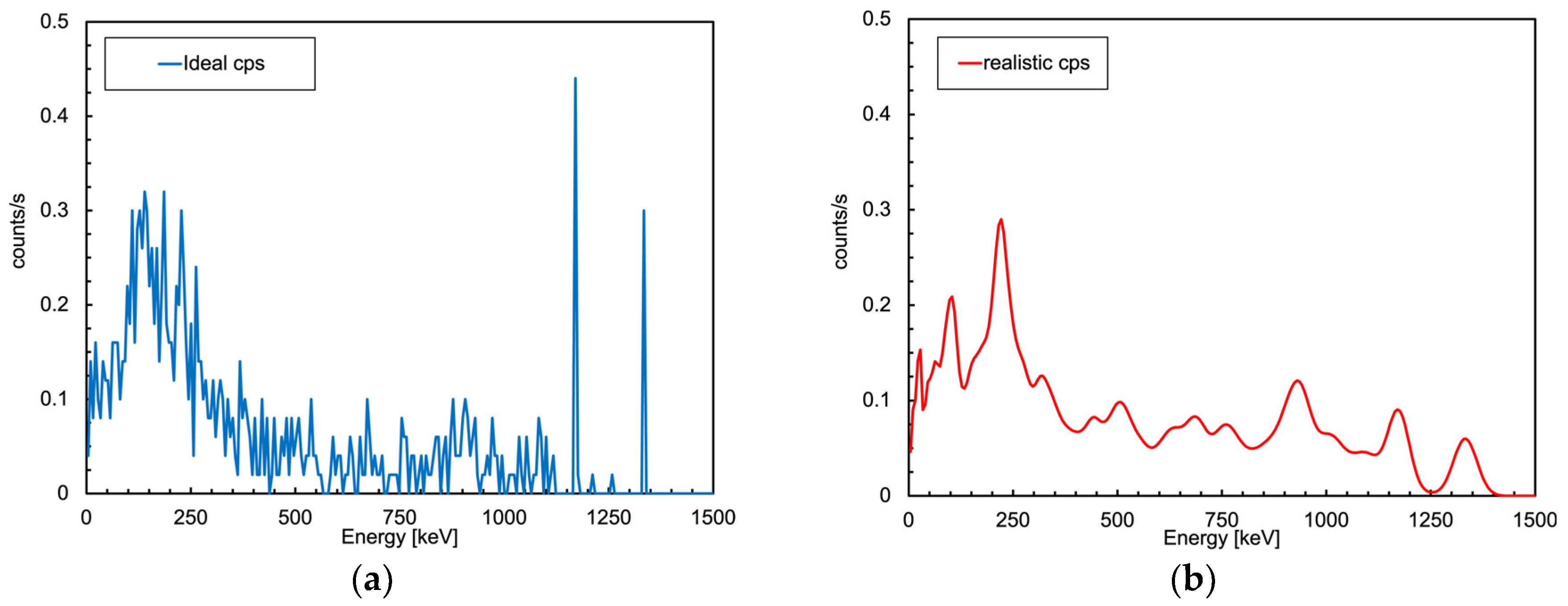
Table 1.
Results from measurements and simulations in the six areas investigated. The direct dose rate was obtained multiplying the measured count rate by the dose conversion factor of 0.037 (µSv/h)/(counts/s). For the measured and simulated dose rates see the following chapter. The quoted uncertainties are statistical only.
Table 1.
Results from measurements and simulations in the six areas investigated. The direct dose rate was obtained multiplying the measured count rate by the dose conversion factor of 0.037 (µSv/h)/(counts/s). For the measured and simulated dose rates see the following chapter. The quoted uncertainties are statistical only.
| Location | tag | run time [s] |
count rate [cps] | average dose rate(direct) [µSv/h] |
average dose rate(measured) [µSv/h] |
dose rate (simulation) [µSv/h] |
|---|---|---|---|---|---|---|
| ambient, in sources region | a | 110 | 5.97 | 0.22 ± 0.009 | 0.13 ± 0.005 | - |
| amid 152Eu, 137Cs, 60Co | b | 40 | 7.23 | 0.27 ± 0.016 | 0.17 ± 0.010 | - |
| 137Cs, 60Co | c | 110 | 12.43 | 0.46 ± 0.012 | 0.44 ± 0.012 | ≈ 0.4 |
| 241Am | d | 70 | 7.59 | 0.28 ± 0.012 | 0.18 ± 0.008 | ≈ 0.12 |
| 152Eu | e | 120 | 7.39 | 0.27 ± 0.009 | 0.18 ± 0.006 | ≈ 0.1 |
| ambient, far from sources | f | 80 | 4.04 | 0.15 ± 0.008 | 0.07 ± 0.004 | - |
Disclaimer/Publisher’s Note: The statements, opinions and data contained in all publications are solely those of the individual author(s) and contributor(s) and not of MDPI and/or the editor(s). MDPI and/or the editor(s) disclaim responsibility for any injury to people or property resulting from any ideas, methods, instructions or products referred to in the content. |
© 2024 by the authors. Licensee MDPI, Basel, Switzerland. This article is an open access article distributed under the terms and conditions of the Creative Commons Attribution (CC BY) license (http://creativecommons.org/licenses/by/4.0/).
Copyright: This open access article is published under a Creative Commons CC BY 4.0 license, which permit the free download, distribution, and reuse, provided that the author and preprint are cited in any reuse.
MDPI Initiatives
Important Links
© 2024 MDPI (Basel, Switzerland) unless otherwise stated



